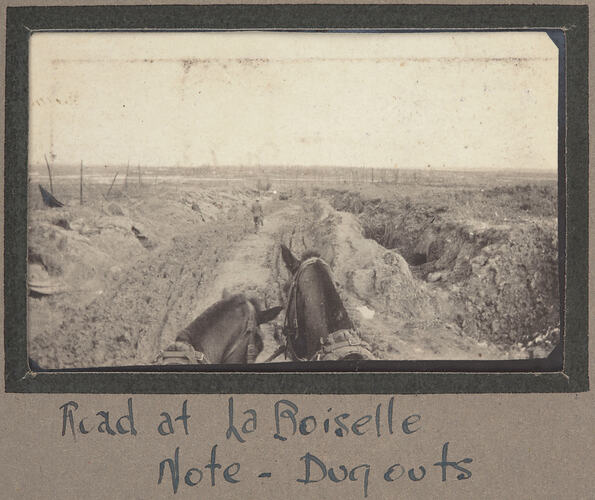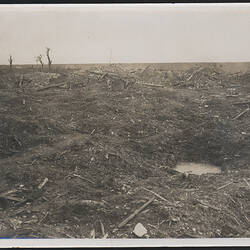Summary
Black and white photographic print which depicts the largely destroyed landscape surrounding the village of La Boiselle. La Boiselle was on the frontline when the Battle of the Somme began on July 1st 1916, and after heavy fighting, came to be in Allied hands by the 4th of July. It was nearby La Boiselle on the morning of July 1st 1916 that the British detonated a number of mines underneath the German frontline, which as a result created the largest mine crater (90 feet deep and 300 feet across) on the Western Front. It soon became a well known battlefield landmark to the men of the AIF on their way to the frontline at Pozieres. The caption to this photograph specifically highlights the dug-outs used by soldiers on the frontline. Dug-outs were used by soldiers as a form of shelter, place of rest, area to eat their meals and conduct meetings.
It is one of 95 black and white, and, sepia toned photographs taken in France during World War I, attached to a photograph album. The album includes a few photographs of enemy prisoners, the war cemetery at Warloy, a wrecked German ambulance and images of the local French people.
Most photographs are of Albert and surrounds so it would seem probable that most were taken during and after the Battle of the Somme (1916). In addition there are also photographs dated 1917. The photographs were taken by Private John Edward Lord, 13th Field Ambulance, and brought back to Australia by him and compiled in an album at the end of the First World War.
The album is one of many souvenirs brought back to Australia after World War I by Lord, and is part of a larger collection of photograph albums, images, documents and World War I memorabilia donated by Lord to Museum Victoria.
Description of Content
The photograph is taken from the front seat of a wagon, looking down onto the horses and the scene in front. In the foreground the heads of the two horses leading the wagon are visible. There is a soldier a short way in the distance walking in front. The scene beyond the wagon shows an open field that had been turned into a battle ground. A dirt pathway stretches in front. On the right hand side of the image a disused dugout can be seen. On the left hand side of the image a row of burnt trees remain. In the background of the photograph rows of more burnt trees are visible.
Physical Description
Monochrome photograph, mounted in a small, grey photograph album.
Significance
This album appears to have been prepared to 'showcase' the war experiences of John Lord and the photographs associated with these. The album has been very carefully prepared and the quality of the photographs is generally good, in comparison to the album ST40491, also compiled by John Lord, which has a number of photographs which are of poor quality, many photographs removed and written in (mostly) illegible pencil. This suggests this album was most probably compiled after the war, with photographs probably gathered from other photograph albums of Lord's.
The subjects of the photographs are of trenches (both German and Allies), horses, camps, farms, graves and cemeteries, civilians, soldiers, churches and other buildings. Many of the photographs were taken around the town of Albert and are dated 1916 and 1917. From this information we can tell that Lord was involved with the Battle of the Somme when these photographs were taken.
The Battle of the Somme was fought from north of the Somme river between the towns of Albert and Arras. The Battle began on the 1 July and was called off on the 18 November 1916. The Battle of the Somme is famous for the loss of 58,000 British troops (one third of them killed) on the first day of the battle, 1 July 1916, which to this day remains a one-day record.
More Information
-
Collection Names
-
Collecting Areas
-
Acquisition Information
Donation from J. Lord, 1986
-
Place & Date Depicted
-
Photographer
Sergeant John Lord, La Boiselle, Somme, France, 1916-1917
Image may have been taken by Lord or collected by him for use in this album. -
Format
Photograph, Monochrome
-
Inscriptions
Hand written in ink on matt directly below photograph: 'Road at La Boiselle / Note - Dugouts'
-
Classification
-
Category
-
Discipline
-
Type of item
-
Image Dimensions - Photograph
66 mm (Width), 44 mm (Height)
-
Image Dimensions - Photograph album page
192 mm (Width), 146 mm (Height)
-
Keywords
Australian Army, Militaria: Australian, Military Memorabilia, Souvenirs, Wars & Conflicts, World War I, 1914-1918, Battle of the Somme (Somme Offensive), 1916


